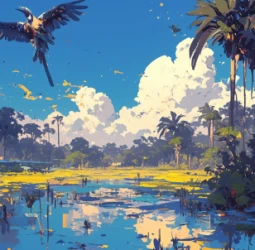Wildlife Corridors: Connecting Habitats for the Protection of Biodiversity in Brazil
Brazil is home to a vast array of species, from colorful birds like macaws and toucans to majestic big cats like jaguars and ocelots. This diverse wildlife is not only essential for maintaining the balance of ecosystems within the country but also for the global biodiversity.
However, rapid urbanization, deforestation, and human activities have threatened the survival of many species in Brazil. One of the most effective solutions to this challenge is the establishment of wildlife corridors.
What are Wildlife Corridors?
Wildlife corridors, also known as ecological corridors or landscape linkages, are strips of habitat that connect fragmented areas and allow animals to move between them. These corridors can be natural, such as rivers and mountain ranges, or man-made, such as roads or overpasses specifically designed for animal use.
Why are Wildlife Corridors Necessary?
In Brazil, deforestation is one of the primary causes of habitat fragmentation. The destruction of natural habitats forces animals to search for food and shelter in smaller and isolated areas, making them more vulnerable to threats such as poaching and diseases. This isolation also reduces genetic diversity, making species more susceptible to extinction.
Wildlife corridors play a crucial role in mitigating these effects. By connecting fragmented habitats, they allow animals to move freely and safely between areas, ensuring better access to resources and increasing their chances of survival. They also promote gene flow, helping to maintain genetic diversity within species.
The Importance of Habitat Connectivity
Habitat connectivity is vital for the survival of wildlife in Brazil. It not only allows animals to access resources and find mates but also facilitates the natural movement of populations, preventing inbreeding.
Furthermore, habitat connectivity is essential for the proper functioning of ecosystems. It allows for the migration of important pollinators and seed dispersers, which are crucial for maintaining healthy plant communities.
The Role of Brazil's Biodiversity
Brazil is known for its incredible biodiversity, with the Amazon Rainforest alone being home to approximately 10% of all known species on Earth. This makes the protection and preservation of its wildlife crucial not only for the country but also for the planet.
By establishing wildlife corridors, Brazil can ensure the continuity of its diverse ecosystems, supporting the survival of its numerous species and contributing to global biodiversity conservation efforts.
Examples of Wildlife Corridors in Brazil
There are already successful examples of wildlife corridors in Brazil. One such corridor is the Transpantaneira, a 147-kilometer road that connects the Pantanal region with the Cerrado, two of the most biodiverse areas in Brazil. This road has been designed with approximately 120 underpasses, allowing animals to move safely between the two regions.
Another successful project is the Atlantic Forest Corridor, which aims to restore and connect fragments of the Atlantic Forest, one of the most threatened biomes in Brazil. This corridor will connect the Serra do Mar and the Serra da Mantiqueira mountain ranges, supporting the survival of numerous species, including the endangered golden lion tamarin.
The Future of Wildlife Corridors in Brazil
While there are already several wildlife corridor projects in Brazil, there is still a need for more extensive and strategic planning. The country's rapid development and growing population pose a continuous threat to its wildlife, making the protection and preservation of its habitats a top priority.
Government support and collaboration with local communities, NGOs, and scientists are essential for the success of wildlife corridors in Brazil. With these efforts, we can ensure the continued survival of Brazil's diverse wildlife and contribute to the conservation of global biodiversity.
Brazil is home to a vast array of species, from colorful birds like macaws and toucans to majestic big cats like jaguars and ocelots. This diverse wildlife is not only essential for maintaining the balance of ecosystems within the country but also for the global biodiversity.
However, rapid urbanization, deforestation, and human activities have threatened the survival of many species in Brazil. One of the most effective solutions to this challenge is the establishment of wildlife corridors.
What are Wildlife Corridors?
Wildlife corridors, also known as ecological corridors or landscape linkages, are strips of habitat that connect fragmented areas and allow animals to move between them. These corridors can be natural, such as rivers and mountain ranges, or man-made, such as roads or overpasses specifically designed for animal use.
Why are Wildlife Corridors Necessary?
In Brazil, deforestation is one of the primary causes of habitat fragmentation. The destruction of natural habitats forces animals to search for food and shelter in smaller and isolated areas, making them more vulnerable to threats such as poaching and diseases. This isolation also reduces genetic diversity, making species more susceptible to extinction.
Wildlife corridors play a crucial role in mitigating these effects. By connecting fragmented habitats, they allow animals to move freely and safely between areas, ensuring better access to resources and increasing their chances of survival. They also promote gene flow, helping to maintain genetic diversity within species.
The Importance of Habitat Connectivity
Habitat connectivity is vital for the survival of wildlife in Brazil. It not only allows animals to access resources and find mates but also facilitates the natural movement of populations, preventing inbreeding.
Furthermore, habitat connectivity is essential for the proper functioning of ecosystems. It allows for the migration of important pollinators and seed dispersers, which are crucial for maintaining healthy plant communities.
The Role of Brazil's Biodiversity
Brazil is known for its incredible biodiversity, with the Amazon Rainforest alone being home to approximately 10% of all known species on Earth. This makes the protection and preservation of its wildlife crucial not only for the country but also for the planet.
By establishing wildlife corridors, Brazil can ensure the continuity of its diverse ecosystems, supporting the survival of its numerous species and contributing to global biodiversity conservation efforts.
Examples of Wildlife Corridors in Brazil
There are already successful examples of wildlife corridors in Brazil. One such corridor is the Transpantaneira, a 147-kilometer road that connects the Pantanal region with the Cerrado, two of the most biodiverse areas in Brazil. This road has been designed with approximately 120 underpasses, allowing animals to move safely between the two regions.
Another successful project is the Atlantic Forest Corridor, which aims to restore and connect fragments of the Atlantic Forest, one of the most threatened biomes in Brazil. This corridor will connect the Serra do Mar and the Serra da Mantiqueira mountain ranges, supporting the survival of numerous species, including the endangered golden lion tamarin.
The Future of Wildlife Corridors in Brazil
While there are already several wildlife corridor projects in Brazil, there is still a need for more extensive and strategic planning. The country's rapid development and growing population pose a continuous threat to its wildlife, making the protection and preservation of its habitats a top priority.
Government support and collaboration with local communities, NGOs, and scientists are essential for the success of wildlife corridors in Brazil. With these efforts, we can ensure the continued survival of Brazil's diverse wildlife and contribute to the conservation of global biodiversity.



 dev1
dev1















